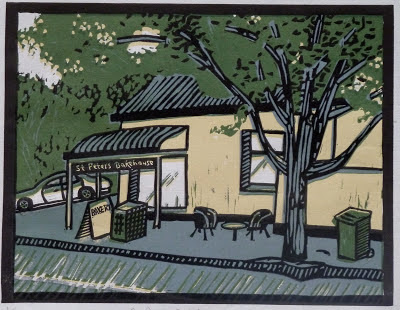Another printmaking process I like to experiment with is etching. It is a fairly process driven technique as there are a number of steps to achieve a satisfactory end result.
Various metals can be used for the matrix plate, such as zinc, steel and aluminium, but I like copper the best for its ability to retain delicate lines and leave very little plate tone behind. (Unfortunately copper is also fairly expensive)! I begin with a sheet of copper, then bevel the edges so they are no longer sharp. I degrease the copper plate by rubbing it over with a mix of whiting powder, vinegar and water, wash it off, then cover the front and back in bitumen, (a kind of waxy resist), to protect the metal in the etching process.
To create a line etching I use a variety of sharp tools (anything goes! needles, nails, skewers, steel wool etc) to carve into the bitumen, leaving areas of the copper exposed. Once I am happy with my design, I place the plate into a "bath" of ferric chloride to etch the exposed areas of the copper. The rest is safely protected with my bitumen layer. Different metals etch slightly differently, but for copper I check it fairly regularly and take it out to rinse off the build up of gunk which forms with etching. When I feel that my lines are deep enough, I take out the plate and remove the bitumen layer. I can now do a proof!
After I have set up my printing press to the right height and placed my paper in a water bath, I use a piece of card to spread the ink over the entire surface of the plate, making sure I get into the etched lines. I take as much ink off the surface as possible, then use tarlatan scrunched into a ball to push the ink further into the grooves and take off the excess. I then use either my hand or thin paper such as leaves from a phone book to remove the rest of the excess ink on the surface of the plate, still making sure I leave the ink in the etched lines. I clean up the edges, then place the plate facing up on the bed of the press. My wet paper is patted dry, then placed over the plate. Felt blankets are placed on top as they are used in this printing process to help push the paper right into the grooves and pick up all the ink. Once run through the press I can now peel back the paper and see the results!
If I am happy with my proof print, I can go ahead and print the edition. If I feel like I need to add something else, I begin the entire process again!
 |
Hübbe Court, 2010
Etching on zinc (edition of 4) |
The image above was the very first etching I ever made. Now that I have had lots of practise in between there are some things I would do differently, such as clean up the edges and have a more even plate tone. But I still remember the thrill of trying a new technique and the excitement of peeling back the paper for the first time!
 |
Ghosts, 2011
Multiplate etching and aquatint on copper (uneditioned) |
This image was created using two copper plates, one inked in blue and the other in black. The black fish were done using the line etching method I have described above, but the blue...I'll be getting to that...in the next blog!

















